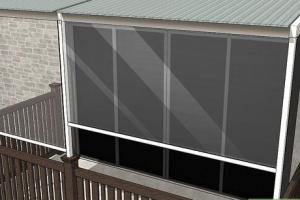Ultimate Guide to Protecting Your Balcony from Rain: Effective Solutions

-
Quick Links:
- Introduction
- Why Cover Your Balcony?
- Options for Covering Your Balcony
- Step-by-Step Guide to Covering Your Balcony
- Case Studies
- Expert Insights
- FAQs
Introduction
Balconies can be a wonderful extension of your living space, offering a place to relax and enjoy the outdoors. However, rain can quickly turn this serene escape into a soggy inconvenience. In this comprehensive guide, we will explore various methods to effectively cover your balcony from rain, ensuring you can enjoy your outdoor area regardless of the weather.
Why Cover Your Balcony?
Covering your balcony has several advantages:
- Protection from Weather: A covered balcony shields you from rain, snow, and harsh sunlight.
- Increased Usability: You can use your balcony year-round, regardless of weather conditions.
- Enhanced Aesthetics: A well-designed cover can enhance the overall look of your home.
- Increased Property Value: Outdoor spaces that are usable and attractive can boost your home's market value.
Options for Covering Your Balcony
There are several effective solutions for covering your balcony. Here, we’ll break down the most popular options:
1. Awnings
Awnings are a popular choice for providing shade and rain protection. They come in various styles, including retractable and fixed options.
2. Pergolas
A pergola can provide partial shelter while allowing some light to filter through. You can add climbing plants or fabric for additional coverage.
3. Canopies
Canopies are versatile and can be easily set up and taken down. They are available in various materials and sizes, making them suitable for any balcony.
4. Waterproof Tarps
Tarps are an inexpensive solution for rain protection. They can be secured over your balcony and removed when not needed.
5. Glass Balustrades
For a modern look, glass balustrades can provide wind and rain protection while maintaining visibility and light.
6. Roof Extensions
If you are considering a more permanent solution, extending your home’s roof over the balcony can provide excellent coverage.
Step-by-Step Guide to Covering Your Balcony
Now that you know your options, here’s a step-by-step guide to covering your balcony effectively.
Step 1: Assess Your Needs
Determine what you need from your balcony cover. Will you only need it for rain, or do you also want shade from the sun? How much space do you have?
Step 2: Choose Your Material
Depending on your chosen option, select materials that are durable and weather-resistant. For example, acrylic or polycarbonate is excellent for canopies, while fabric awnings should be waterproof.
Step 3: Installation
Follow the manufacturer’s instructions for installation. If you’re building a pergola or extending your roof, you may need professional help.
Step 4: Add Accessories
Consider adding accessories such as outdoor furniture, plants, or lighting to enhance the usability and aesthetic of your covered balcony.
Step 5: Maintenance
Regular maintenance is key to ensuring your balcony cover lasts. Clean materials regularly and check for any damage due to weather.
Case Studies
To illustrate the effectiveness of these options, let’s look at a few case studies of successful balcony covers:
Case Study 1: Urban Apartment with Retractable Awning
An urban couple installed a retractable awning on their balcony. They reported significant improvements in usability during rainy days and appreciated the aesthetic appeal.
Case Study 2: Suburban Home with a Pergola
A family built a pergola over their balcony and added climbing vines. They found it provided great rain protection while enhancing their garden’s beauty.
Expert Insights
We consulted with outdoor living experts to gather insights on the best practices for covering balconies. Here’s what they had to say:
- Dr. Jane Smith, Landscape Architect: “Always consider the weight of the materials you use. Ensure your balcony can support it.”
- John Doe, Home Improvement Specialist: “Choose a style that complements your home’s architecture for the best aesthetic appeal.”
FAQs
1. What is the best material for covering a balcony?
The best material depends on your needs, but options like polycarbonate, fabric, and wood are popular choices.
2. How do I maintain my balcony cover?
Regularly clean the materials and check for any wear or damage, especially after storms.
3. Can I install a cover myself?
Many covers can be installed DIY, but for complex structures like pergolas, professional help is advisable.
4. Are there any building regulations for balcony covers?
Yes, always check local building codes and regulations before installing a balcony cover.
5. How much does it cost to cover a balcony?
The cost varies widely based on materials, size, and installation complexity but can range from $500 to $5,000.
6. Can a covered balcony still get sunlight?
Yes, many options allow sunlight to filter through, such as awnings and pergolas.
7. What are the benefits of a retractable awning?
Retractable awnings provide flexibility, allowing you to adjust coverage based on the weather.
8. How long does a balcony cover last?
With proper maintenance, most balcony covers can last anywhere from 5 to 15 years.
9. Can I use my balcony in winter with a cover?
Yes, a well-designed cover can protect you from rain and snow, allowing year-round use.
10. What is the best way to secure a tarp over a balcony?
Use bungee cords or rope to secure the tarp, ensuring it is tight and won’t flap in the wind.
Random Reads
- How to set up tekkit server
- How to set up two computers for lan
- How to set up wireless hotspot windows command prompt
- How to open pptx file on iphone or ipad
- How to open python file
- How to remove rounded nut or bolt
- How to remove scratch from granite countertop
- How to use net send
- How to use ms dos
- How to restart your computer using the keyboard